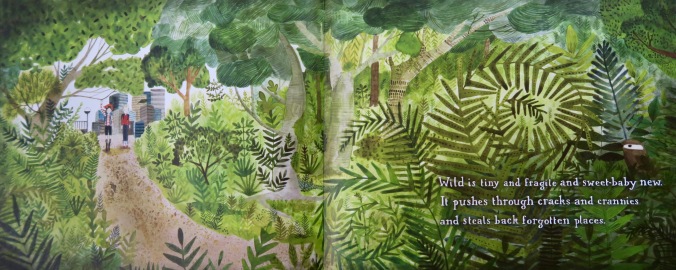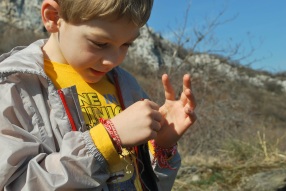Learning Intention: I can find nature in my nearby surroundings.
Featured Book: Finding Wild by Megan Wagner Lloyd

Finding Wild is an excellent book to read before setting out on any sort of nature hunt. It helps children to understand what wild is and helps them to understand that wild exists even in the most man-made environments and sets the tone for exploring their own local environments.
Inside
I start off by asking students what they think “wild” means to them. They inevitably focus on wild animals. I ask them why a bear is wild, but not a dog. Then I steer it away from animals by asking if various things around the school are wild. Is the classroom wild? Is the soccer field? How about the blacktop? A rock?
I read the book, Finding Wild. When I’m done, I ask students if they think we will find wild in the schoolyard, and what sort of wild things we might find, then lead the discussion towards bugs: will find any bugs? are bugs wild? what kinds might we find?

An excerpt from Finding Wild
I tell them that we are going to be hunting for bugs. Before we go out, I show them the containers that we use. I have a set of single serve yoghurt and fruit cup containers. I explain that I’m not giving them lids because we want the bugs to be able to escape. I also show them a paintbrush, which will allow them to gently sweep the bug into their containers if they are squeamish.
I also bring out a few larger containers with lids, so if anyone finds anything particularly interesting, we can keep it for a bit longer so everyone can see it.
Outside
The proceeding nature hunt can be done anywhere, really. I focussed on bugs because there are bugs pretty much everywhere. Even a barren, paved schoolyard or a classroom will have nugs (or at least signs of them).

Before I hand out the containers and send them on their way, we take a few moments to have students sit quietly and watch the ground for bugs. They will often see one wandering by within a minute. I find this works best on mowed grass. It’s long enough that there are bugs, but short enough that kids can spot them. When I skip this step, half the class will inevitably run around for ten minutes and return complaining that they can’t find anything. Bug hunting takes a bit of stealth and patience.
Once everyone realizes there is no shortage of bugs. I remind them to be gentle with the bugs and not to keep them for too long, remind them of the boundaries, hand out the containers, and send them on their way.

As kids bring bugs to show me, I ask them to pay attention to the number of legs, the number of body parts, what the eyes look like, or any other features of behaviours that stand out.
As with most of my nature activities, I keep them going until the energy starts to dip, or until we run out of time.
I also bring a small terrarium so I can keep any particularly interesting bugs to show the rest of the class. As soon as everyone has seen it, I let them go.
Extra Ideas
If you have access an insect or spider field guide, bring it along. Kids love field guides, and using them is a great skill.
Get containers with lids and get kids to draw or describe the insects as part of their nature journaling.
Have to students keep track of what they found. When you get back inside, you can make a graph to show what the class found the most of.
Discussion Questions
Where did you find the most bugs? Why do you think you found more there?
How did your bugs react when you caught them?
Does anyone know what kinds of bugs they caught?
Raise your hand if you found an ant/spider/slug/centipede etc.
What kind of bug did you find the most of?
Can you find wild in this place?
Did you find anything wild other than bugs?
Is there somewhere where you don’t think you would find wild?
Caution: Except for the very rare sightings of black widows, we don’t have any dangerous bugs around here, but it is something to consider. Take a bit of time to assess the risk before setting out bug hunting. If you decide to go ahead, a lesson on the dangerous bugs (or creatures that share a habitat with bugs) should certainly be in order. Gloves and paintbrushes can create some distance between kids and bugs as well.